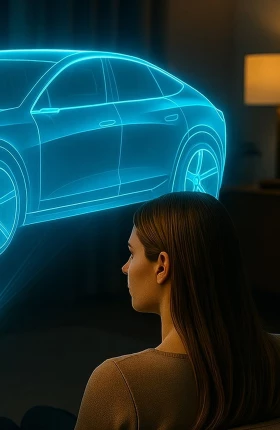Artificial intelligence and generative artificial intelligence may seem contrary to the emotions, aspirations, and personal bonds that have always made luxury luxury. But the shifting expectations of clients, their increasing fragmentation, and their ongoing dissatisfaction with the buying experience all indicate an urgent need for change that is ideally suited to what AI and GenAI offer.
The combination of these technologies radically transforms how brands can engage with clients and how many clients they can engage with. (See Exhibit 1.) It unlocks advantages of service quality and personalization at scale across channels in ways that are otherwise not achievable for most luxury brands today. At a time when growth in the sector is slowing, these advantages will build a foundation for stronger growth by extending the experience of very, very important clients (VVICs) to very important clients (VICs).
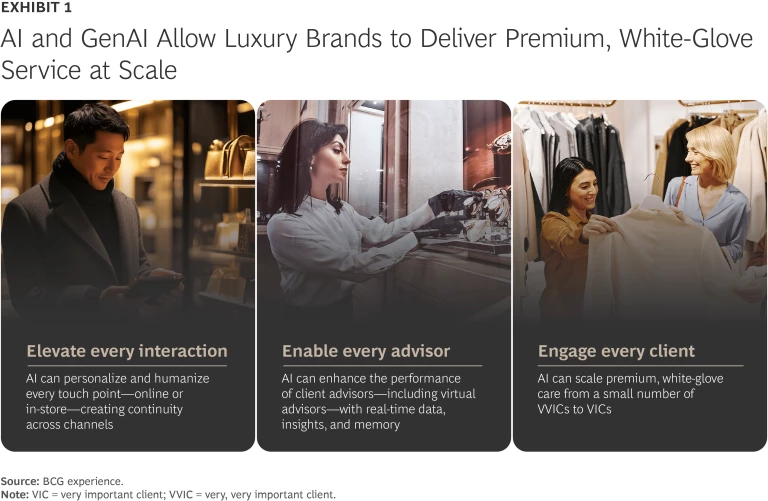
Luxury brands have generally been reluctant to make a full commitment to AI and GenAI, in part because these tools may be perceived as impersonal and create a burden in terms of data collection. They also did not see the technologies as a high priority when they were nurturing white-glove service for VVICs and enjoying steady growth from other clients.
But brands now have compelling reasons to change that perspective. Sector growth is slowing, competition is intensifying, and one of the key insights from BCG’s 2025 Luxury CX and AI Global Survey reveals another challenge: 56% of respondents reported that they are not satisfied with their luxury-shopping experience.
Key finding: 56% of luxury clients are unsatisfied with their luxury-shopping experience.
Stay ahead with BCG insights on artificial intelligence
Luxury Clients Are Changing Rapidly
Luxury clients have high service expectations, are shopping online more frequently, and increasingly accept AI’s role in luxury shopping. Luxury brands are trailing their clients in these areas, and the gap between them is growing. While brands could make incremental modifications aimed at catching up and improving the overall level of client satisfaction, the ongoing advancements in AI and GenAI create a platform for making more fundamental changes. For the first time, luxury brands have the means and urgency to scale their white-glove service.
To elevate their service levels and attract new clients, luxury brands need to adapt to several trends that are intensifying among their current and prospective clients, particularly in the VIC segment.
Heightened Expectations. Clients—especially the new generation—are comparing their luxury-shopping experience against their positive service experiences in other sectors. The pervasiveness of digital use in daily life, now augmented with AI, is leading clients to superimpose their service expectations onto luxury shopping, often with underwhelming results. Luxury clients in our survey expressed frustration with the need to enter personal data repeatedly. They don’t feel recognized or valued when client advisors have no knowledge of their special occasions or preferences. They also cited impersonal and incongruous follow-up and engagement from advisors post-purchase.
Personal recognition, helpful reminders and recommendations, as well as easy repairs and returns are table stakes for most consumer-facing service businesses. Luxury brands cannot afford to let their rare and special luxury experience fall short of what clients have come to expect from the mass market.
Growing Online Share. While 64% of survey respondents said they made their most recent luxury purchase in-store, the prevalence of online shopping is increasing. (See Exhibit 2.) Some 38% of clients reported that they shop more online for luxury purchases now than they did three to five years ago.
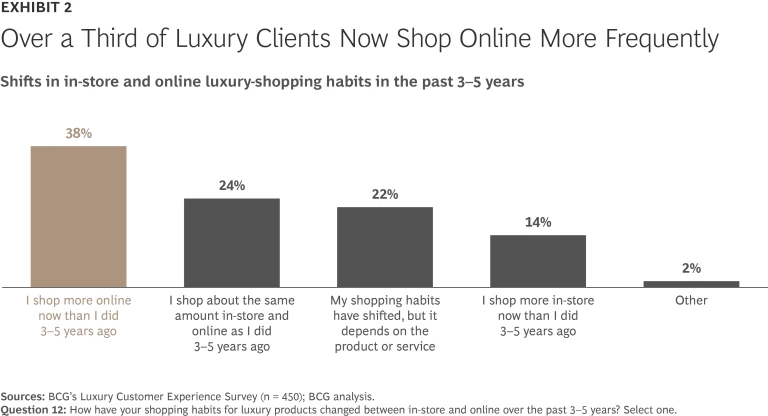
An additional 22% said that their shopping habits have shifted between online and in-store, but it depends on the product or service. Even when the final purchase takes place in the store with the support of a client advisor, luxury clients spend time conducting research and planning online. BCG’s 2023 True-Luxury Global Insights Survey showed that 77% of luxury clients expect continuity in their relationship with a brand across channels, regardless of where they ultimately buy. Once clients are known, they expect to be remembered and recognized.
Readiness for AI and GenAI. Luxury clients indicate that they are ready for a luxury experience enhanced by AI and GenAI. Although the use of AI tools for a luxury-selling ceremony is still relatively low—perhaps because some brands are not yet incorporating these technologies—the enthusiasm for AI is significantly higher, especially for use in the research and post-purchase phases. (See Exhibit 3.)
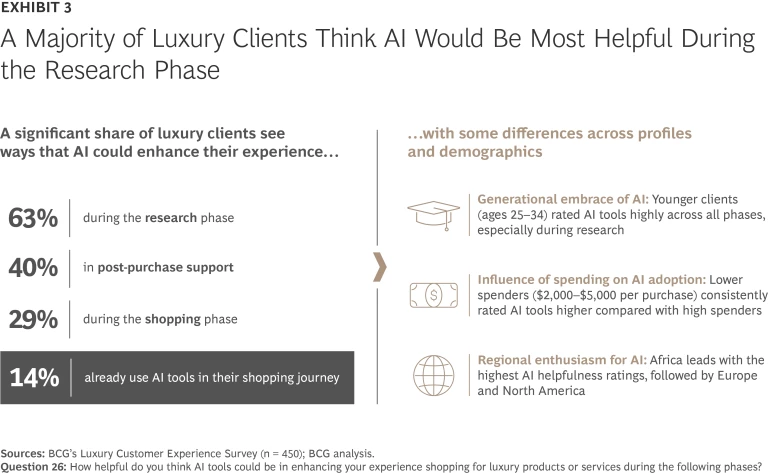
The level of enthusiasm is even greater in certain demographics, revealing the fragmentation of luxury clients across age groups and geographic lines. Younger clients, who are the new generation of luxury clients, rated AI tools highly across all phases of the purchase journey.
Scaling White-Glove Service Is Today’s Imperative
AI and GenAI are not about replacing the human connection in luxury but about enhancing it through thoughtful, behind-the-scenes support. These tools radically expand the means of engagement with a larger number of clients, both online and offline, in ways that enrich the service experience and can reignite sector growth. That makes it imperative that luxury brands use these technologies to extend the white-glove service beyond the realm of the VVICs.
AI and GenAI can personalize and humanize every touch point—in-store and online—to create a seamless buying experience across channels. The tools have advanced to a level that allows luxury brands to cultivate “superhuman” client advisors and enhance the online self-discovery experience.
Superhuman Client Advisors. Client advisors already use many forms of communication and interaction to build deeper relationships with clients. But even the best client advisors face practical limitations in the number of clients they can interact with and the amount of personal detail they can recall reliably.
The combination of AI and GenAI gives client advisors access to a complete and current institutional memory that can improve the quality and focus of their work in many ways. This real-time access to client insights—together with intelligent intuition and automated proactive prompts—can enable advisors to deliver “wow moments” at scale. (See Exhibit 4.)
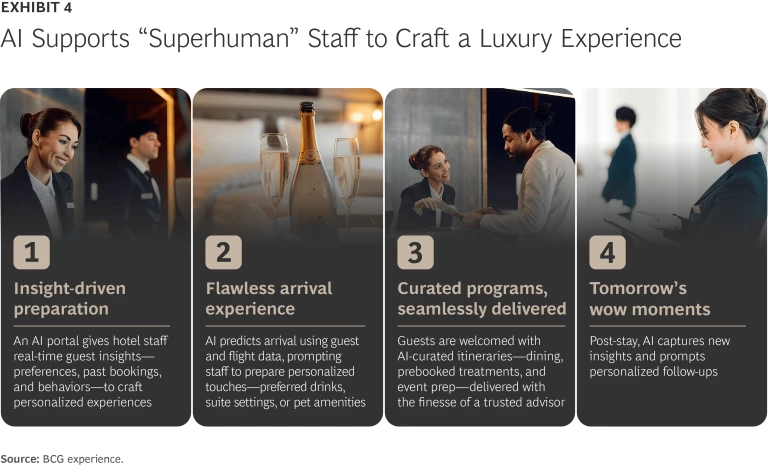
The technologies do this by identifying the most promising leads, scheduling follow-ups, and prompting the client advisor with clients’ relevant personal information and purchase history when they visit in person. AI and GenAI can also draft personalized communication that the advisor can edit to strike the right emotional tone. These steps transform the idea of “mass personalization”—with the inherent risks of inauthenticity—into an approach that’s unique to the individual client and still feels natural to the advisor.
This mix of automation and genuine personal touch allows advisors to engage a much larger number of clients and at the same time repurpose their time to give qualified traffic their full attention. That traffic can come from an advisor’s direct outreach or through the client’s research.
Enhanced Self-Discovery. By automating and elevating digital touch points online, AI and GenAI can guide clients to smarter product discovery, follow-ups, and service. These interactions can take place without a human but also without losing the essence of the luxury experience. The recognition and support that current or prospective clients receive online should be comparable to the service they would expect in real life.
User-friendly tools for search, scheduling, and purchase make the self-discovery experience enjoyable. When clients don’t find something that meets their specific demands right away, an embedded invisible intelligence can show the same spark of creativity that a human would have and recommend a similar product. Clients are already growing accustomed to AI-inspired answers and recommendations in other contexts, as they start to move away from the traditional online searches and view the more conversational interactions with AI as a superior outcome. Exhibit 5 shows one example of enhanced self-discovery.
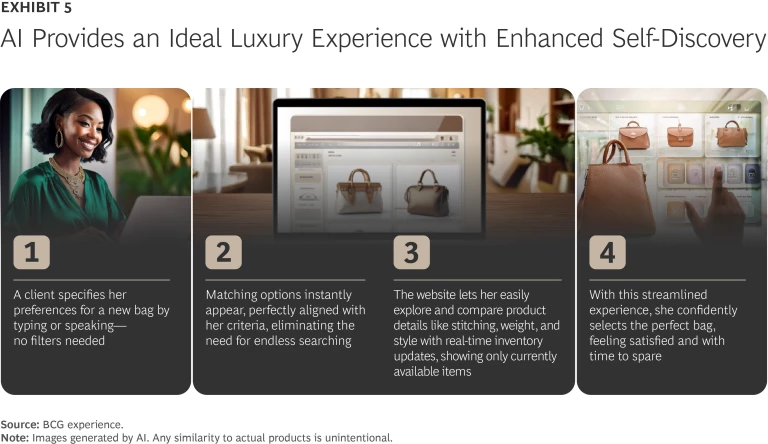
Communication through a virtual client advisor can guide online discovery with the same intuition and expertise as a human advisor. If desired, the virtual advisor can also make a seamless handoff to a real-life advisor for a direct conversation and provide its colleague with the necessary information about the client’s wishes, preferences, and purchase history. Because GenAI is natively conversational, it can be trained to use the right tone and language—adapted to the content—to create a luxury impression.
Balance the Technology with the Risks to the Brand Experience
In other sectors, AI has already proved itself to be an ideal way for companies to capitalize on client fragmentation and high expectations by achieving the desired level, timing, and nature of personalization at scale.
Nonetheless, the deployment of AI is not an automatic and rapid cure-all for the dissatisfaction that more than half of luxury clients feel. Some clients and brands worry that AI’s misapplication risks making high-end experiences feel robotic or transactional. Respondents in our survey expressed these concerns as well, with 62% of participants saying that the biggest risk of AI and GenAI is losing the human touch.
We don’t downplay these concerns but believe that the commercial hazards of not deploying AI and GenAI far outweigh those other risks. By establishing the standard for premium white-glove service in an AI-powered world, first movers can gain new clients in the VIC segment and beyond, while preserving margins and enhancing the experience for VVICs. Brands that follow or delay will ultimately need to make similar if not higher investments—but without the promise of similar returns—to keep up with the brands that are ahead of them on the experience curve and have established new standards for excellence.
It’s Time to Embed AI into the Team
Many luxury brands have already begun exploring AI, particularly through predictive analytics. Historically, though, they’ve been slow to adopt transformative platforms like e-commerce. Now, with the maturation of high-touch, white-glove service models, these brands face a rare opportunity to bypass early-stage experimentation and move directly to meaningful integration.
The real winners in this AI transformation won’t be the brands that are cautiously experimenting. They will be the brands that fully commit, recognizing that their clients and adjacent industries are already advancing quickly. Success hinges on rethinking implementation. Rather than isolating individual use cases, brands should define the outcomes they want to achieve and then design operating models and technical architectures that support them. This means treating AI not as a tool but as an embedded team member. By clustering related use cases and aligning them with strategic goals, luxury brands can integrate AI more quickly and effectively.
The payoffs are attractive for luxury brands that go all-in on AI and GenAI, beyond the acceleration of productivity. Such a commitment strengthens cultural leadership, sharpens relevance with new generations of clients, and redefines what it means to offer truly exceptional service at scale. This is not just about doing more—it’s about becoming more.






